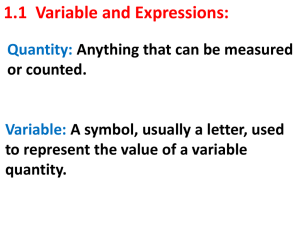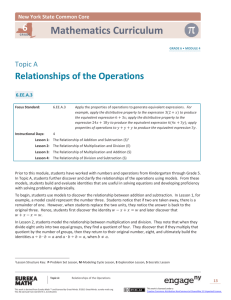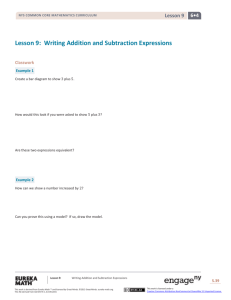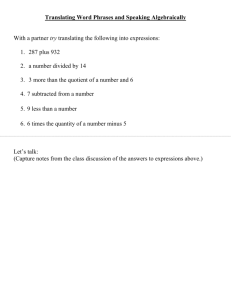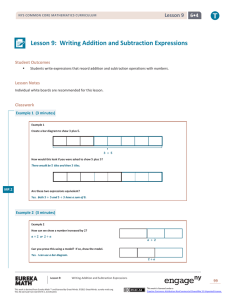Reading Algebraic Expressions: Lesson Plan for Middle School Math
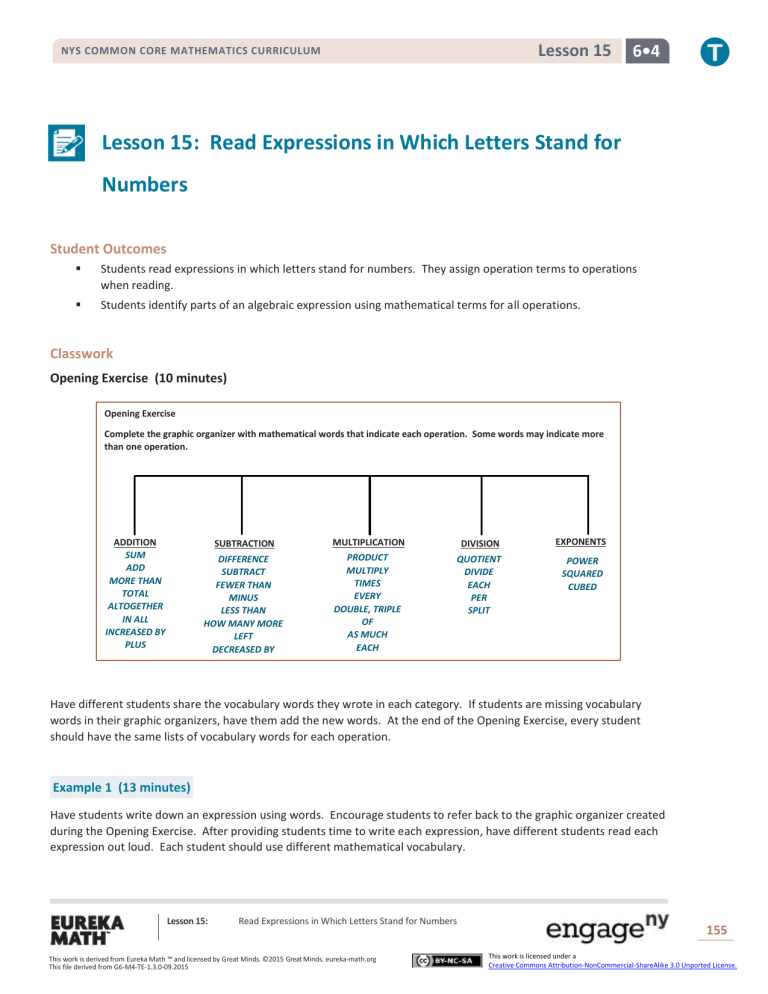
NYS COMMON CORE MATHEMATICS CURRICULUM
Lesson 15 6•4
Lesson 15: Read Expressions in Which Letters Stand for
Numbers
Student Outcomes
Students read expressions in which letters stand for numbers. They assign operation terms to operations when reading.
Students identify parts of an algebraic expression using mathematical terms for all operations.
Classwork
Opening Exercise (10 minutes)
Opening Exercise
Complete the graphic organizer with mathematical words that indicate each operation. Some words may indicate more than one operation.
ADDITION
SUM
ADD
MORE THAN
TOTAL
ALTOGETHER
IN ALL
INCREASED BY
PLUS
SUBTRACTION
DIFFERENCE
SUBTRACT
FEWER THAN
MINUS
LESS THAN
HOW MANY MORE
LEFT
DECREASED BY
MULTIPLICATION
PRODUCT
MULTIPLY
TIMES
EVERY
DOUBLE, TRIPLE
OF
AS MUCH
EACH
DIVISION
QUOTIENT
DIVIDE
EACH
PER
SPLIT
EXPONENTS
POWER
SQUARED
CUBED
Have different students share the vocabulary words they wrote in each category. If students are missing vocabulary words in their graphic organizers, have them add the new words. At the end of the Opening Exercise, every student should have the same lists of vocabulary words for each operation.
Example 1 (13 minutes)
Have students write down an expression using words. Encourage students to refer back to the graphic organizer created during the Opening Exercise. After providing students time to write each expression, have different students read each expression out loud. Each student should use different mathematical vocabulary.
Lesson 15: Read Expressions in Which Letters Stand for Numbers
This work is derived from Eureka Math ™ and licensed by Great Minds. ©2015 Great Minds. eureka-math.org
This file derived from G6-M4-TE-1.3.0-09.2015
155
This work is licensed under a
Creative Commons Attribution-NonCommercial-ShareAlike 3.0 Unported License.
MP.6
NYS COMMON CORE MATHEMATICS CURRICULUM
Example 1
Lesson 15 6•4
Write an expression using words. a.
𝒂 − 𝒃
Possible answers: 𝒂 minus 𝒃 ; the difference of 𝒂 and 𝒃 ; 𝒂 decreased by 𝒃 ; 𝒃 subtracted from 𝒂 b.
𝒙𝒚
Possible answers: the product of 𝒙 and 𝒚 ; 𝒙 multiplied by 𝒚 ; 𝒙 times 𝒚 c.
𝟒𝒇 + 𝒑
Possible answers: 𝒑 added to the product of 𝟒 and f; 𝟒 times 𝒇 plus 𝒑 ; the sum of 𝟒 multiplied by 𝒇 and 𝒑 d.
𝒅 − 𝒃 𝟑
Possible answers: 𝒅 minus 𝒃 cubed; the difference of 𝒅 and the quantity 𝒃 to the third power e.
𝟓(𝒖 − 𝟏𝟎) + 𝒉
Possible answers: Add 𝒉 to the product of 𝟓 and the difference of 𝒖 and 𝟏𝟎 ; 𝟓 times the quantity of 𝒖 minus
𝟏𝟎 added to 𝒉 . f.
𝟑 𝒅+𝒇
Possible answers: Find the quotient of 𝟑 and the sum of 𝒅 and 𝒇 ; 𝟑 divided by the quantity 𝒅 plus 𝒇 .
Why is 3 divided by 𝑑 plus 𝑓 not a correct answer?
Possible answer: 3 divided by 𝑑 plus 𝑓 would indicate that we divide 3 and 𝑑 first and then add 𝑓 , but this is not what the expression is showing.
Exercises (12 minutes)
Students work with a partner to complete the following problems.
Exercises
Circle all the vocabulary words that could be used to describe the given expression.
1.
𝟔𝒉 − 𝟏𝟎
Scaffolding:
If students are using the vocabulary words well or finish early, ask students to write two different expressions for
Exercises 1–4.
ADDITION
2.
𝟓𝒅
𝟔
SUM
SUBTRACTION
DIFFERENCE
MULTIPLICATION
PRODUCT
DIVISION
QUOTIENT
Lesson 15: Read Expressions in Which Letters Stand for Numbers
This work is derived from Eureka Math ™ and licensed by Great Minds. ©2015 Great Minds. eureka-math.org
This file derived from G6-M4-TE-1.3.0-09.2015
156
This work is licensed under a
Creative Commons Attribution-NonCommercial-ShareAlike 3.0 Unported License.
NYS COMMON CORE MATHEMATICS CURRICULUM
3.
𝟓(𝟐 + 𝒅) − 𝟖
ADD SUBTRACT MULTIPLY
Lesson 15
DIVIDE
4.
𝒂𝒃𝒄
MORE THAN LESS THAN TIMES EACH
Write an expression using vocabulary words to represent each given expression.
5.
𝟖 − 𝟐𝒈
Possible answers: 𝟖 minus the product of 𝟐 and 𝒈 ; 𝟐 times 𝒈 subtracted from 𝟖 ; 𝟖 decreased by 𝒈 doubled
6.
𝟏𝟓(𝒂 + 𝒄)
Possible answers: 𝟏𝟓 times the quantity of 𝒂 increased by 𝒄 ; the product of 𝟏𝟓 and the sum of 𝒂 and 𝒄 ; 𝟏𝟓 multiplied by the total of 𝒂 and 𝒄
7.
𝒎+𝒏
𝟓
Possible answers: the sum of 𝒎 and 𝒏 divided by 𝟓 ; the quotient of the total of 𝒎 and 𝒏 , and 𝟓 ; 𝒎 plus 𝒏 split into
𝟓 equal groups
8.
𝒃 𝟑 − 𝟏𝟖
Possible answers: 𝒃 cube 𝒅 minus 𝟏𝟖 ; 𝒃 to the third power decreased by 𝟏𝟖
9.
𝒇 − 𝒅
𝟐
Possible answers: 𝒇 minus the quotient of 𝒅 and 𝟐 ; 𝒅 split into 𝟐 groups and then subtracted from 𝒇 ; 𝒅 divided by 𝟐 less than 𝒇
10.
𝒖 𝒙
Possible answers: 𝒖 divided by 𝒙 ; the quotient of 𝒖 and 𝒙 ; 𝒖 divided into 𝒙 parts
6•4
Closing (5 minutes)
Peter says the expression 11 − 3𝑐 is 3 times 𝑐 decreased by 11 . Is he correct? Why or why not?
Peter is not correct because the expression he wrote is in the wrong order. If Peter wanted to write a correct expression and use the same vocabulary words, he would have to write 11 decreased by 3 times 𝑐 .
Exit Ticket (5 minutes)
Lesson 15: Read Expressions in Which Letters Stand for Numbers
This work is derived from Eureka Math ™ and licensed by Great Minds. ©2015 Great Minds. eureka-math.org
This file derived from G6-M4-TE-1.3.0-09.2015
157
This work is licensed under a
Creative Commons Attribution-NonCommercial-ShareAlike 3.0 Unported License.
NYS COMMON CORE MATHEMATICS CURRICULUM
Name
Lesson 15 6•4
Date
Lesson 15: Read Expressions in Which Letters Stand for Numbers
Exit Ticket
1.
Write two word expressions for each problem using different math vocabulary for each expression. a.
5𝑑 − 10 b.
𝑎 𝑏+2
2.
List five different math vocabulary words that could be used to describe each given expression. a.
3(𝑑 − 2) + 10 b.
𝑎𝑏 𝑐
Lesson 15: Read Expressions in Which Letters Stand for Numbers
This work is derived from Eureka Math ™ and licensed by Great Minds. ©2015 Great Minds. eureka-math.org
This file derived from G6-M4-TE-1.3.0-09.2015
158
This work is licensed under a
Creative Commons Attribution-NonCommercial-ShareAlike 3.0 Unported License.
NYS COMMON CORE MATHEMATICS CURRICULUM
Exit Ticket Sample Solutions
Lesson 15
1.
Write two word expressions for each problem using different math vocabulary for each expression. a.
𝟓𝒅 − 𝟏𝟎
Possible answers: the product of 𝟓 and 𝒅 minus 𝟏𝟎 , 𝟏𝟎 less than 𝟓 times 𝒅 b.
𝒂 𝒃+𝟐
Possible answers: the quotient of 𝒂 and the quantity of 𝒃 plus 𝟐 , 𝒂 divided by the sum of 𝒃 and 𝟐
2.
List five different math vocabulary words that could be used to describe each given expression. a.
𝟑(𝒅 − 𝟐) + 𝟏𝟎
Possible answers: difference, subtract, product, times, quantity, add, sum b.
𝒂𝒃 𝒄
Possible answers: quotient, divide, split, product, multiply, times, per, each
Problem Set Sample Solutions
1.
List five different vocabulary words that could be used to describe each given expression. a.
𝒂 − 𝒅 + 𝒄
Possible answers: sum, add, total, more than, increase, decrease, difference, subtract, less than b.
𝟐𝟎 − 𝟑𝒄
Possible answers: difference, subtract, fewer than, triple, times, product c.
𝒃 𝒅+𝟐
Possible answers: quotient, divide, split, per, sum, add, increase, more than
2.
Write an expression using math vocabulary for each expression below. a.
𝟓𝒃 − 𝟏𝟖
Possible answers: the product of 𝟓 and 𝒃 minus 𝟏𝟖 , 𝟏𝟖 less than 𝟓 times 𝒃 b.
𝒏
𝟐
Possible answers: the quotient of 𝒏 and 𝟐 , 𝒏 split into 𝟐 equal groups c.
𝒂 + (𝒅 − 𝟔)
Possible answers: 𝒂 plus the quantity 𝒅 minus 𝟔 , 𝒂 increased by the difference of 𝒅 and 𝟔 d.
𝟏𝟎 + 𝟐𝒃
Possible answers: 𝟏𝟎 plus twice 𝒃 , the total of 𝟏𝟎 and the product of 𝟐 and 𝒃
6•4
Lesson 15: Read Expressions in Which Letters Stand for Numbers
This work is derived from Eureka Math ™ and licensed by Great Minds. ©2015 Great Minds. eureka-math.org
This file derived from G6-M4-TE-1.3.0-09.2015
159
This work is licensed under a
Creative Commons Attribution-NonCommercial-ShareAlike 3.0 Unported License.

